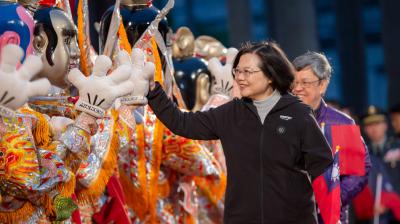Taiwan's competition for diplomatic recognition mainland China
This commentary has previously been published by the University of Nottingham Taiwan Insight, the online magazine of the Taiwan Studies Programme.
Diplomatic allies are vital for the continuity of the Republic of China (ROC). Its Government relies on diplomatic recognition to legitimise its claim to sovereignty, contradicting the mainland Chinese claim that Taiwan is but a renegade province of mainland China. Furthermore, Taiwan’s diplomatic allies can lobby for its inclusion in international organisations. However, ever since the Democratic Progressive Party (DPP) was elected to rule Taiwan over the more Beijing-friendly Kuomintang (KMT) in 2016, the mainland Chinese Government has once again started poaching Taiwanese diplomatic allies in retaliation. This ended the ‘diplomatic truce’ that was established during KMT rule of the island from 2008 to 2016, in which the costly competition for diplomatic recognition between the two governments was put on hold. Subsequently, Taipei has lost eight diplomatic allies to Beijing, reducing the number of states that officially recognise the ROC to 15. Still, as the 2020 electoral results showed, this did not prevent another DPP victory. How did the Tsai Government respond to mainland China’s attempts to reduce its diplomatic allies from 2016 to 2020? Was this a vastly different strategy from previous foreign policy?
Steadfast Diplomacy
President Tsai coined her overall approach to the conflict as ‘steadfast diplomacy with mutual assistance for mutual benefits.’ introducing the term on her first official overseas trip to Panama and Paraguay. In an official statement, the meaning of ‘steadfast diplomacy’ was explained as two-folded:
“1. To be ‘unwavering’ in our pursuit of greater international space for Taiwan, by working with diligence and pragmatism, taking one steady step at a time and solving every diplomatic challenge we meet.
2. To be ‘firm in purpose’ in upholding freedom and democracy, and to work closely with countries that share these values, not only to benefit each other, but to contribute tangibly to the international community.”
Though this was branded as the Tsai administration’s ‘new thinking.’ it shares many similarities with previous foreign policy, and its definition remains rather vague. In official statements, the emphasis seems to be on the ‘mutual assistance for mutual benefits.’ So, rather than a one-way aid that generates no returns for Taiwan, the DPP wishes to use diplomatic resources more efficiently with “mutually beneficial arrangements whereby both sides discuss thoroughly and plan together, under the principle of financial openness and transparency.” This adapts Taiwanese policy to its limited diplomatic resources, which the Ministry of Foreign Affairs explicitly identified as weakness and challenge constraining foreign policy by the Ministry of Foreign Affairs.
These statements are primarily aimed at domestic audiences, justifying the vast amount of resources that the ROC spends on its diplomatic allies. The ‘mutual benefits’ discourse seeks to distinguish Tsai’s rule from DPP rule under President Chen Shui-bian, which was strongly criticised for its opaque use of presidential funds for diplomatic relations. In addition, geared towards its international audience, the DPP seeks to distinguish its ‘steadfast diplomacy’ from mainland China’s methods to use financial inducements to convince states to derecognise Taiwan. The ROC refers to these efforts as ‘dollar diplomacy’, accusing mainland China of bribing governments with untransparent financial gifts and false promises of foreign assistance that solely benefit Government leaders, rather than the country’s population or its broader overall development. The DPP has been criticised, among others by the KMT, of also using dollar diplomacy to maintain its diplomatic allies,and takes great pains to counter these accusations.
Old Wine, New Bottles?
Other than the ‘new’ mutual assistance for mutual benefits, steadfast diplomacy seems to continue many of the same foreign policy strands as the ROC pursued under KMT rule. However, the DPP is more vocal in criticising mainland China than the KMT was. These methods are outlined in the bi-annual Foreign Policy Reports to the Legislative Yuan by the Ministry of Foreign Affairs under the DPP, which unfailingly identify mainland Chinese suppression as one of the main challenges facing Taiwan, and promote steadfast diplomacy as a solution. Concerning the maintenance of diplomatic allies, the reports consistently highlight the same key tasks, which remained the same before and after the DPP was elected in 2016. Firstly, this involves ‘consolidating ties with diplomatic allies’ by promoting mutual official visits and increasing official development assistance. With the COVID-19 pandemic, this now also includes medical diplomacy with the ‘Taiwan Can Help’ campaign. However, official visits could not prevent Taiwan from losing several allies. For example, in 2017 Panama broke official ties with the ROC despite President Tsai’s official visit only a year before.
Furthermore, another critical task that remained the same under DPP and KMT rule is ‘deepening relations with like-minded countries and other nations with which Taiwan does not maintain diplomatic relations.’ Crucial here are the United States, Japan, and the European Union, which the Government singles out as its most important unofficial relations. In these relations, the DPP Government always stresses their shared values and support for democracy and freedom to underline their similarities. The American-Taiwanese relationship especially has grown stronger in recent years, as marked by Under Secretary of State’s Keith Krach’s recent visit to the island, the highest-ranking representative from the State Department to visit in over 40 years. The Taiwanese Government also celebrated the Trump administration’s Taipei Allies International Protection and Enhancement Initiative (TAIPEI) and the Taiwan Travel Act as foreign policy victories.
A third tenet of steadfast diplomacy concerning the diplomatic competition for recognition is ‘proactive steps to make our voice heard internationally’ through public diplomacy. Here, the Tsai Government is more proactive in its public diplomacy than the previous KMT Government. Indeed, it has established official social media accounts and given extended interviews in mainstream international media to increase its reach to the global public and provide a counternarrative to mainland China’s claim that Taiwan is a wayward province. Thus, these three essential tasks are the core of Taiwan’s steadfast diplomacy against China’s derecognition policies.
Steadfast Allies?
Overall, the Tsai administration’s steadfast diplomacy exhibits more continuities with its predecessors’ foreign policy than it cares to admit. Especially the large sums of development aid and assistance to diplomatic partners are a costly and unsustainable method to protect its alliances. The global downturn caused by the COVID-19 pandemic will only make its allies more vulnerable to economic persuasion. With only 15 diplomatic allies left, and the mainland Chinese pressure to switch recognition only rising, the stakes are higher than ever before. With these bleak prospects, Taiwan’s unofficial partners are increasingly more important than the dwindling number of official diplomatic allies. In recent years, the US especially has made encouraging moves to support Taiwan in the international community. The ROC’s foreign policy should reflect these changing circumstances. It should focus its efforts on nurturing support from international heavyweights as much as possible. In the end, the Taiwanese Government must hope that its steadfast diplomacy will convince its partners to remain steadfast in their support as well.
Follow @XiaoxueMartin on Twitter.







